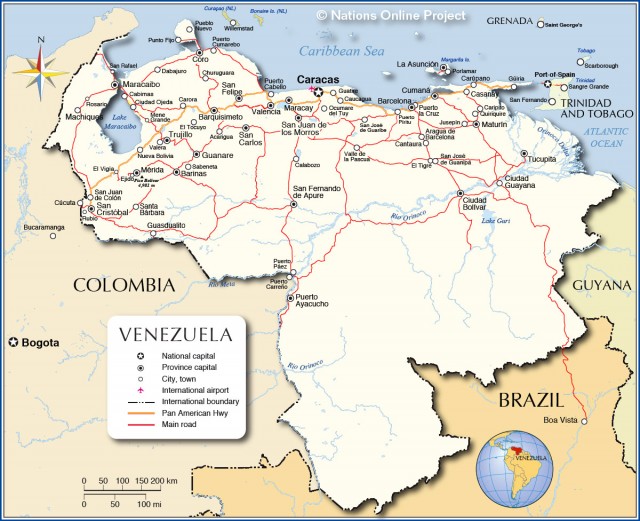Venezuela
Area 352,144 square mi (912,050 square km)
Population 30.69 million 2014
Capital Caracas
Highest Point 16,427 ft (5,007 m)
Lowest Point 0 m
GDP $381.3 billion 2012
Primary Natural Resources petroleum, natural gas, iron ore, gold.
VENEZUELA IS A COUNTRY in northern South America. A former Spanish colony, Venezuela formed part of the country of Gran Colombia after achieving independence in the early 19th century. In 1830, Venezuelan broke away from the other Gran Colombian nations of COLOMBIA and ECUADOR.
The country is slightly smaller than twice the size of CALIFORNIA. The CARIBBEAN SEA and ATLANTIC OCEAN border Venezuela to the north and east. Venezuela also shares borders with BRAZIL, Colombia, and GUYANA. The country can be divided into six geographic regions: the coast, the Segovia Highlands, the ANDES, the coastal range, the llanos, and Guayana.

At the eastern end of the coastal region is the 250-mi- (402-km-) long Orinoco Delta. Consisting of low plains and swamps, the delta provides a natural entryway to the interior of Venezuela. Early European explorers and missionaries used the delta to travel inland. Later, the delta was used to get to the country's mineral resources.
However, because the Orinoco Delta is hot and rainy and possesses few resources, human settlements in the region are scarce. At the western end of the coastal region lies Lake Maracaibo. In the 20th century, the discovery of oil made the Lake Maracaibo region a key part of the country, as petroleum came to dominate the Venezuelan economy. While oil brought much wealth to the region, it also brought many environmental problems.
There are a number of important port cities along the Venezuelan coast. They include Puerto Cabello, Cumana, and Barcelona. The most import port is La Guaira. While it does not possess the best natural harbor in Venezuela, La Guaira achieved its position because of its location near the capital city of Caracas and its rich agricultural areas. The coastal region also includes a number of islands. Chief among them are Margarita, Coche, and Cubagua. During the colonial period, the islands were an important source of pearl fishing. By the twentieth century, tourism and commerce played a key role, especially on Margarita.
The Segovia Highlands consist of high plains and low, broken hills, with a relatively hot and dry climate. The highlands are located at altitudes between 1,600 and 2,600 ft (487 to 792 m). Four mountain formations—the Northern, Barbacoas, Baragua, and Lara Mountains—surround two savanna areas, known as the plains of Falcon and the Lara Depression. During the 1500s, European settlers made their way from the coast to the Lara Depression and established a number of important towns, including El Tocuyo and Barquisimeto. These towns in turn served as a base for further exploration of the central Coastal Range. The Segovia Highlands provided land suitable for raising cattle and growing crops, along with a source of Native American labor.
In the Venezuelan Andes, two ranges surround a series of valleys. The highest peaks are located near the city of Merida and reach 16,400 ft (4,999 m). Most of the main cities and towns, such as Trujillo, Bocono, and San Cristobal, are located in the valleys at altitudes between 2,600 and 5,380 ft (792 and 1,640 m). An existing native population for labor, fertile land, and a cool climate attracted many settlers to the Venezuelan ANDES. The Andes region of Venezuela has been important historically because of the cultivation of coffee and as a source of political power. In the 19th century, coffee was Venezuela's principal crop and the country was an important exporter. Many national leaders have hailed from the Andes. Notable among them were Cipriano Castro and Juan Vicente Gomez, who ruled the country from 1899 until 1935.
Venezuela's coastal range is the political and economic center of the country. The range is made up of low mountains that are divided into eastern and western sections separated by the Unare basin. The western section, known as the Central Coastal Range, is home Venezuela's principal cities, including the capital of Caracas. Founded in 1567, Caracas quickly became the most important city during the Spanish colonial period. After playing a key role in the struggle for independence in the early 19th century, Caracas became the capital of an independent Venezuela. In the second half of the 20th century, Caracas grew into a major metropolis.
Also known as the Orinoco River plains, the Venezuelan LLANOS consist of tropical grassland, with some woodlands along the rivers. A cycle of draught and floods regulates the lives of those living in the llanos. The rainy season leads to flooding, while the dry season often causes shortages of water and grazing land. Traditionally, the llanos has depended on a cattle economy, producing largely for the domestic market. In the early 19th century, the llanos played a crucial role in Venezuela's wars of independence, providing many soldiers to the conflict. In the 20th century, the oil also began to play a role in the region's economy
and politics.
The Guayana region can be divided into two parts. The plains of western Guayana follow the Orinoco and Casiquiare Rivers. These plains are largely sandy-soil grasslands with scattered palm groves. These grasslands are fragile and do not support large-scale livestock raising. The rest of the region consists of distinctive, steep, flat-topped mountains. These mountains contain many spectacular waterfalls, including Angel Falls, the world's highest waterfall. The mountainous regions also possess mineral resources such as iron ore. Guayana has long been a frontier area in Venezuela and was not thoroughly mapped out until the 20th century with the advent of aerial mapping. Ineffective occupation made it difficult for the government to maintain its claims to territory disputed with Great Britain. Indeed, in a boundary dispute with Great Britain in 1895, Venezuela lost a significant amount of territory. The region became more developed in the 20th century with the growth of Ciudad Guayana as an industrial center.